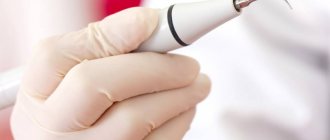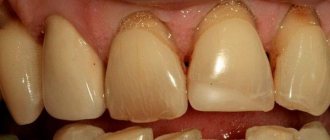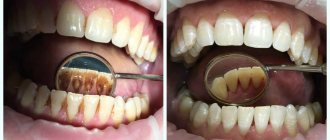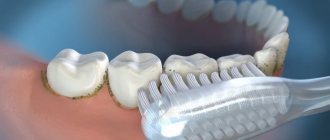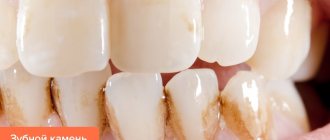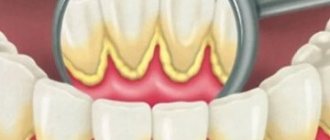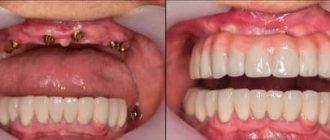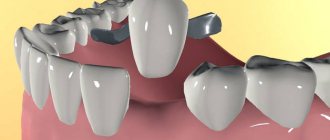Tartar not only disrupts the aesthetics of a smile, but leads to gum disease, bad breath, the development of dental caries and, in advanced cases, tooth loss.
Regular teeth cleaning using ultrasound removes hard plaque from the surface of the teeth and from shallow periodontal pockets (maximum up to 5 mm), the procedure is carried out using a special device - a dental scaler (scaler). The device can be built into a dental unit or stand-alone.
An ultrasonic scaler consists of a control unit and vibration generation unit, a handpiece, removable (replaceable) attachments and a control pedal. The device is equipped with a liquid supply system. During operation, the device creates ultrasonic vibrations with a frequency of 25-30 kHz, which are transmitted to the tip nozzle.
Physical principle of operation: an ultrasonic wave is transmitted from the tip to the scaler nozzle, which in turn transfers it to dental plaque. Under its influence, deposits are destroyed from the inside. To prevent damage to tooth enamel, the dentist moves the attachment strictly along the surface of the tooth. The simultaneous supply of water to the zone of ultrasound influence provokes the effect of cavitation, the formation of micro-bubbles in the volume, which accelerate the process of destruction of tartar. At the same time, water or a medicinal solution helps wash away dental plaque destroyed by ultrasound from the treatment area.
Operating principle of ultrasonic cleaning
Tartar removal using ultrasound is based on the destructive effect of high-frequency waves on hard deposits. The procedure is carried out using a special attachment - a scaler.
The directed action of the waves explains the fact that the stone practically crumbles before our eyes, turning into powder. The simultaneous supply of water washes away plaque and cools the tooth, relieving discomfort.
The main advantage of the method is that using a scaler you can clean subgingival pockets. Laser and chemical cleaning do not provide this opportunity.
Another important point is the bactericidal effect. Under the influence of ultrasonic waves, pathogenic bacteria that cause dental damage and oral diseases die.
Benefits of dental
Our dental specialists perform treatment of the oral cavity with an ultrasonic scaler. Using modern, high-performance equipment allows us to give a beautiful smile and maintain dental health to dozens of patients every day.
Our honey the centers are located in different areas, but within walking distance from metro stations. Addresses of dentists can be found on the website. Each patient can make an appointment for a primary and secondary appointment at a convenient time. Administrative advice can be obtained by calling the contact number. You can make an appointment for ultrasonic teeth cleaning by phone or online on our website.
Is ultrasonic teeth cleaning harmful?
Hygienic teeth cleaning with ultrasound does not have a negative effect on the human body and is recognized by experts as absolutely harmless. The only thing is that there are a number of restrictions, in the presence of which it is not recommended.
Ultrasonic cleaning is a mandatory procedure before prosthetics, installation of braces and implants. It is also recommended that those suffering from periodontitis visit their dentist or hygienist twice a year.
Signs of tartar:
- visible plaque on the enamel - primarily appears on the inner surface of the teeth, as well as on the root part;
- bad breath in the absence of diseased teeth is explained by the vital activity of pathogenic bacteria;
- inflammation, bleeding, swelling of the gums;
- the appearance of pronounced gingival pockets.
Important. If you notice these signs, you should immediately consult a doctor.
What types of formations are there?
From a practical point of view, specialists separate hard plaque depending on its location. It can be supragingival and subgingival.
- Supragingival tartar is clearly visible even during visual inspection. To a greater extent, its accumulations are found on the most distant teeth and on the inside of the front teeth of the lower jaw.
- Subgingival tartar is invisible during a routine examination of the oral cavity at a mirror, since it is concentrated under the gum, in periodontal pockets. Only a doctor can detect such deposits using dental instruments. The reason for contacting professionals to clarify the situation and carry out a hygienic procedure should be such signs as red or bleeding gums, bad breath.
Depending on the location of the tartar, the doctor chooses the most optimal way to remove it.
Reasons for appearance
The appearance of tartar is associated with the following prerequisites:
- Failure to comply with hygiene rules, when cleaning teeth with a toothbrush and toothpaste is carried out irregularly or is of insufficient quality. At the same time, there are always places in the oral cavity of any person where it is not easy to remove plaque on your own: the interdental spaces, the area of the neck of the teeth.
- Lack of dense foods in the diet that promote self-cleaning of teeth.
- Chewing on one side only, which occurs when teeth are lost or pain on the other.
- The presence of pathological processes in the body, characterized by impaired mineralization of saliva and an increase in its viscosity.
The formation of tartar is also promoted by a developmental anomaly such as crowded teeth.
Methods for removing tartar
Soft plaque can be removed using simple methods such as a toothbrush and toothpaste, as well as using the Air Flow device. However, in the case of hard tartar, these methods will not be effective due to its stony nature. The desired effect can be achieved with ultrasound . This procedure guarantees results in all hard-to-reach places, including subgingival pockets. During this process, it will be possible to get rid of pathogenic bacteria.
Operating principle of ultrasonic cleaning
method of removing tartar is based on the use of a special apparatus equipped with a tip with a special attachment. In it, electrical energy is converted into ultrasonic energy and directed to areas that need treatment. Under the influence of ultrasound, a dense stone is separated from the tooth surface and crushed into separate, smaller parts, which are then easily removed from the oral cavity with a stream of water or suction. In this case, the dentist can change the operating mode of the scaler, selecting the most suitable oscillation frequency.
Pros and cons of ultrasonic tartar removal
Advantages of ultrasonic cleaning:
- Highly effective for a variety of localizations of tartar, its occurrence between teeth, under the gums, and in the area of periodontal pockets.
- Safety, since damage to the structure of tooth enamel is excluded, as can happen during mechanical cleaning with instruments, hooks and brushes. Thanks to modern equipment, ultrasound does not have a negative effect on existing restorations in the oral cavity or installed veneers.
- Quite comfortable feeling. Possibility of using local anesthesia with a low pain threshold.
- Short session duration, no more than one hour.
- Availability.
Disadvantages of ultrasonic cleaning:
- Some restrictions on the use of the technique . Contraindications to ultrasonic dental tartar removal the patient has a pacemaker, increased tooth sensitivity, severe heart pathology with arrhythmia, or bronchial asthma. You will also have to use alternative methods in case of pregnancy or respiratory tract infection.
- Age restrictions, when due to the too thin layer of enamel of baby teeth, the use of this method of exposure is contraindicated in children.
How to clean teeth with ultrasound: stages
Ultrasound removal of tartar at clinic begins with an examination of the oral cavity, identification of all areas of accumulation of dental plaque, and identification of associated factors that may influence the choice of method .
If the decision is made in favor of ultrasound, then the doctor prepares the scaler, connects it to a source that generates an ultrasonic wave, and directs the nozzle to the areas of greatest accumulation of mineral deposits. As small particles form, they are removed from the mouth.
According to patient reviews , tartar removal takes place in comfortable conditions. Generally, people rate the sensations during the procedure as painless. They can be unpleasant when a large amount of tartar accumulates or when periodontal pockets are treated. In these cases, pain can be avoided by using local anesthesia.
The procedure does not end there. The next stage is teeth polishing, aimed at eliminating all irregularities and microcracks that form on the enamel after cleaning the teeth. The remaining roughness will become a prerequisite for the subsequent adhesion of microparticles of food, cariogenic bacteria and the formation of plaque. At the same time, a high-quality procedure will slow down the process of plaque re-formation and will keep your teeth smooth and shiny. Teeth are polished using special polishing attachments, as well as pastes of varying degrees of abrasiveness. Since they are supplemented with useful substances that help strengthen teeth, the preventive effect is only enhanced.
Fluoridation of teeth can be an independent method of prevention. However, in an effort to obtain the most significant result of ultrasonic cleaning, specialists often include it as part of a comprehensive procedure. It is aimed at improving the mineral composition of the enamel, thereby eliminating increased tooth sensitivity, strengthening the enamel, and preventing caries. The essence of fluoridation is the treatment of teeth with preparations containing fluoride ions. After removing tartar with ultrasound, the enamel perfectly absorbs beneficial substances. The procedure involves applying a solution rich in beneficial minerals tooth Instead of a brush, the doctor can also use mouth guards.
When contacting the Evita clinic for professional teeth cleaning, you can count on the hygienist to give advice on maintaining oral hygiene at home, as well as recommendations on what measures should be taken to avoid increased tooth sensitivity after the procedure and prolong the achieved effect . The advice concerns the following conditions:
- Follow a moderate temperature regime for the food you eat, and also temporarily exclude overly sweet or sour foods;
- During the first days, brushing your teeth is necessary after every meal. In this case, a soft toothbrush should be used as a basis, and among toothpastes, preference should be given to a product containing fluoride. You should stop using dental floss for 1-2 days.
A few days after the procedure, hygiene procedures can already be carried out as usual. At the same time, dental will definitely focus on the fact that if you adhere to a white diet and stop smoking for several days after ultrasonic cleaning, then the achieved improvement in the appearance of your teeth can be prolonged.
Most adult patients require ultrasonic cleaning on average twice a year. However, since its frequency is largely influenced by individual prerequisites, the doctor will also indicate the time of the subsequent visit.
How much does it cost to remove tartar using ultrasound?
The price of tartar removal depends on a number of factors:
- Equipment used. Despite the use of modern equipment, the cost of services at the Evita clinic is as competitive as possible.
- The size of the processing area. The noticeable difference in price will depend on whether one tooth or whether ultrasonic cleaning is necessary for the entire dentition.
- Doctor's qualifications. By contacting the Evita center, you will feel from your own experience that the specialists have sufficient practical experience in this field of activity and have the necessary knowledge and skills. According to reviews, ultrasonic tartar removal in our clinic is indeed performed at the proper level.
Taking into account all these factors, as well as the fact that the specialists of the Evita clinic guarantee a high level of procedure, our center is preferred for ultrasonic teeth cleaning. Any person who cares about the condition of their teeth and wants to avoid the need for treatment of caries or periodontitis has every chance to use this service. It is also necessary to consider the possibility of carrying out the procedure in our center due to the fact that the removal of tartar is usually not covered by the compulsory medical insurance policy, and this procedure in other clinics is also carried out only on a paid basis.
Removing tartar at home
Experts' recommendations regarding the removal of soft plaque regarding the use of hygiene accessories such as a toothbrush, toothpaste and floss are clearly developed, and their effectiveness is beyond doubt. As for the elimination of hard dental plaque, the situation here is more complicated, and it is not possible to ensure the required level of hygiene with these means. The result will not be what the patient expected, even if we focus on a toothbrush that uses electrical energy or ultrasound.
Professional teeth cleaning is possible only in a dental center, where it will be carried out by a qualified specialist who has the necessary skills and uses the appropriate equipment.
Prevention of dental plaque
Despite the fact that it is not possible to safely remove tartar at home, every person has the power to prevent its occurrence. With regular and proper oral care, dental plaque can be avoided or its appearance can be delayed. Good oral hygiene ensures that plaque is removed before it hardens. According to the recommendations of experts, you need to brush your teeth twice a day, choosing a toothbrush with soft or medium-hard bristles. Since a regular toothbrush will not give results in the interdental area, special dental floss should not be ignored.
Pros and cons of ultrasonic tartar removal
The ultrasonic tartar removal procedure has significant advantages over other methods of teeth cleaning. It is less traumatic than mechanical removal of deposits, and more functional than chemical and laser treatments. After cleaning, the enamel acquires a natural color, which makes it possible to choose an implant or filling as close as possible to the desired shade.
Advantages
In most cases, dentists prefer the ultrasound method. In one procedure, the doctor can completely treat all teeth, including subgingival pockets, which guarantees the most complete removal of hard deposits.
The main advantages of the procedure include:
- high-quality treatment of the tooth surface, including fissures, without damaging the enamel;
- removal of solid deposits even from the most inaccessible places;
- painlessness of the procedure;
- treatment of periodontal pockets;
- bactericidal effect – complete destruction of pathogenic microflora.
It also makes sense to talk about the prevention of caries, periodontitis, inflammatory diseases of the gums and teeth, since well-polished enamel prevents the rapid settling of deposits.
Important. The procedure does not cause allergic reactions, which is especially important for asthmatics and allergy sufferers.
Flaws
Perhaps the only drawback of the procedure is slight pain on sensitive teeth. In such cases, the doctor uses local anesthesia in the form of a gel. The disadvantages include the presence of contraindications for the patient.
The benefits and harms of the procedure
Having understood the theory of professional teeth cleaning (what it is, what types there are, how the dentist does this procedure), the patient is naturally interested in the advantages and disadvantages. There are many more advantages, these include:
- aesthetically attractive appearance of rows after hygienic manipulations;
- elimination of unpleasant odor from the oral cavity due to getting rid of colonies of pathogenic microorganisms;
- an integrated approach (not only removes accumulated plaque, but also prevents the development of serious dental diseases);
- absence of pain (except when discomfort is associated with pathological conditions and other factors listed in the previous subsection).
Unfortunately, there are also negative sides:
- gum sensitivity increases;
- the risk of injury to the enamel layer increases;
- infection is possible, so some patients are prescribed antibacterial drugs after visiting a hygienist.
How to clean teeth with ultrasound: stages
Your very first step is to go to the dentist. The doctor will do the rest.
The procedure is carried out in several stages:
- applying an anesthetic gel to the surface of the teeth - if necessary;
- directly removing tartar from enamel;
- treatment of subgingival pockets;
- grinding using special pastes;
- polishing - at the request of the patient.
The stone is removed under the action of a scaler with the simultaneous supply of a stream of water.
Modern techniques involve the use of the Air-Flow method together with ultrasound. After hard deposits have been removed, it is possible to treat the teeth with a water-abrasive mixture under pressure. Microscopic soda crystals penetrate even the interdental spaces, clean hard-to-reach places well, and polish the enamel.
The combined use of ultrasound and Air-Flow ultimately gives excellent results. The surface of the teeth becomes smooth, deposits disappear, the teeth look well-groomed, and the smile becomes beautiful.
Important. You should not uncontrollably (and also under control) rub your teeth with soda powder. In this case, you are guaranteed to have thinning enamel, but the deposits will remain in place.
Why do deposits appear on teeth?
The appearance of stone on initially light-colored teeth is due to various pathogenic and conditionally pathogenic microflora. The process is promoted by streptococci, lactobacilli, some types of Treponema and many other bacteria, the treatment of which is impossible due to their widespread distribution. Plaque is nothing more than the products of their active life in the oral cavity.
Daily brushing of teeth is not able to completely remove this deposit, even if done after every meal. After all, not all hard-to-reach places can be reached with a regular brush or thread. Interdental spaces, crevices and grooves in the back teeth, as well as the area of the neck of the tooth are difficult to clean on your own.
Is it painful to brush your teeth with ultrasound?
The procedure is considered painless, but may cause some discomfort if the enamel is sensitive. If the patient has a high pain threshold, he may well do without anesthesia. But in most cases, the dentist applies a special gel to the surface of the teeth. Also, applying water to the tooth when exposed to a scaler helps reduce pain.
Stone removal with 20% discount
Moscow
Will my teeth hurt after brushing?
No, no and NO. On the contrary, all patients, without exception, note extraordinary freshness in their mouth after the procedure. If you can say – even a feeling of lightness. The removed deposits do not put pressure on the enamel, and the feeling of tension in the teeth disappears.
When exposed to a scaler and a water-abrasive mixture under pressure, the gums are massaged. Blood circulation is normalized in the soft tissues, which also provides noticeable comfort in the mouth.
In general, ultrasonic cleaning is great. Having done it at least once, you will come to the dentist once every six months as required. Please note, come with pleasure.
Features of dental plaque in humans
Dental plaque is a kind of film invisible to the naked eye, consisting of living and dead microorganisms and bacteria.
Tartar is already a fairly hardened plaque that has a stronger and denser texture. It cannot be removed with a regular brush and paste.
Both plaque and stone settle on the surface of the teeth, gums, and in the space between the crowns, causing many pathologies. The accumulation of living and dead microorganisms can cause the development of caries, as well as gum diseases (periodontal disease, periodontitis). In addition, deposits spoil aesthetics - teeth become several shades darker and lose their shine. Professional dental cleaning of teeth and gums is necessary, even if the patient brushes his teeth several times daily. Here is the “gold standard” of affordable hygiene and mandatory dental care for teeth and gums.
Contraindications
A significant drawback of the procedure is the presence of contraindications. The doctor will definitely ask if you have any diseases or orthopedic structures, the presence of which implies a refusal to carry out cleaning.
Contraindications in this case include:
- acute bronchitis, asthma;
- diseases of the heart and blood vessels, installed pacemaker;
- infectious diseases, including ARVI;
- first trimester of pregnancy;
- presence of implants, bridges, braces;
- in a separate line – epilepsy, hepatitis, HIV.
It is also not recommended to perform the procedure on children's baby teeth.
Is it possible to brush teeth with ultrasound during pregnancy?
The best period for preventive cleaning is the second trimester of pregnancy. At this time, the child is already reliably protected by the placenta and is actively developing. Increased growth of the skeletal system provokes tooth decay in the mother, so we must try to protect ourselves as much as possible.
Ultrasonic cleaning with the addition of Air-Flow is considered by experts to be one of the best methods of prevention, as it allows you to sanitize the oral cavity as effectively as possible. The risk of caries is reduced, which allows you to simply save your teeth.
Before visiting a dentist, you must obtain permission from a gynecologist, since the decision is made individually, based on the woman’s condition.
Important. Ultrasound does not affect mother and child and does not cause allergies. The procedure is painless, and the mother feels excellent after the session.
Professional cleaning and braces
If a corrective system is installed to correct the bite, you will have to visit the dentist every 3-4 months. In this case, it can be difficult to achieve high-quality hygiene at home, so professionals come to the rescue.
If hygiene procedures are neglected, caries may develop over time. To do this, you will need to dismantle the structure, which will lead to significant financial costs. In addition, the result of partially completed treatment will be useless.
Having figured out why professional teeth cleaning at the dentist is needed and how the procedure works for certain categories of patients, we can conclude that it is important to carry it out for preventive purposes every six months. If you do not resort to this method of cleansing, you cannot avoid carious lesions, pulpitis and other pathological processes. Accumulated plaque is a favorable environment for the growth and reproduction of pathogenic bacteria, so it is important to get rid of it in a timely manner.
Photos before and after ultrasonic teeth cleaning
Author: Elena Kopylova Dentist-therapist, endodontist. Work experience more than 8 years. The information is for reference only. Before treatment, consultation with a doctor is necessary.
